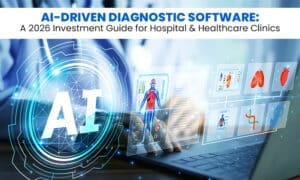
Electronic health records have come a long way from their humble beginnings as simple digital filing systems. Today, they’re the backbone of modern healthcare, quietly revolutionising how doctors treat patients and how hospitals run their operations. But where exactly do we stand with EHR technology in 2025, and what’s coming next? The current state and future trends of EHR paint a fascinating picture of healthcare’s digital transformation. With the global EHR market valued at $36 billion in 2024 and projected to soar to $93 billion by 2035, we’re witnessing unprecedented growth and innovation.
Nearly 96% of hospitals and 78% of office-based physicians have already adopted certified EHR systems, marking a dramatic shift from just 28% of hospitals and 34% of physicians in 2011. This isn’t just about storing patient records digitally anymore – it’s about creating intelligent systems that predict health outcomes, streamline workflows, and ultimately save lives. Implementing AI in healthcare with diagnostics to cloud-based interoperability, the EHR landscape is evolving at breakneck speed, promising to reshape healthcare delivery in ways we’re only beginning to understand.
The Current EHR Landscape: Where We Stand Today
The electronic health records industry has reached a remarkable level of maturity, with widespread adoption across healthcare systems worldwide. Understanding the current state helps us appreciate how far we’ve come and what challenges remain.
Key statistics defining today’s EHR landscape:
- Nearly 96% of non-federal acute care hospitals have adopted certified EHR systems
- 78% of office-based physicians now use certified EHR technology
- Cloud and web-based EHR systems dominate with 83.40% market share
- Hospital segment leads adoption with 52.93% of market revenue
- The United States holds the largest share of the global EHR market
This widespread adoption represents a monumental shift in healthcare delivery. Modern EHR systems have evolved from basic record-keeping tools into comprehensive platforms that support clinical decision-making, population health management, and quality reporting. Healthcare providers now rely on these systems not just for documentation, but for improving patient safety, reducing medical errors, and enhancing care coordination across different providers and settings.
The current EHR environment is characterised by increasing sophistication in user interfaces, better integration capabilities, and enhanced security measures. However, challenges persist around system interoperability, user satisfaction, and the ongoing need for workflow optimisation.
Also Read- Boost Care with a Smart HIMS Software Solution Integration – Ezovion
Market Growth and Financial Projections
The financial trajectory of the EHR market tells a compelling story of sustained growth and increasing investment in healthcare technology. These numbers reflect not just market expansion, but growing confidence in EHR systems’ ability to transform healthcare delivery.
Market value and growth projections:
- Current market value of $28.6 billion in 2024, rising to $30.1 billion in 2025
- Global market expected to reach $93 billion by 2035 with 8.6% CAGR
- US market alone valued at $12.87 billion with 2.55% projected growth
- Alternative projections suggest market could reach $49.4 billion by 2029
- North America dominates with 46.77% of global market share
This robust growth reflects several factors driving EHR adoption and investment. Healthcare organisations are increasingly recognising EHR systems as essential infrastructure rather than optional technology.
The diverse growth projections from different analysts suggest a dynamic market with varying estimates based on different technological and regulatory scenarios. However, all projections point towards significant continued expansion, indicating strong confidence in EHR technology’s future role in healthcare.
Also Read- Pulmonology EHR for Respiratory Specialists
Current Challenges and Pain Points
Despite widespread adoption and market growth, EHR systems face significant challenges that impact user satisfaction and system effectiveness. Addressing these issues is crucial for maximising the benefits of current state and future trends of EHR technology.

Major challenges affecting EHR implementation and use:
- Interoperability issues preventing seamless data sharing between systems
- User interface complexity leading to physician burnout and workflow disruption
- High implementation and maintenance costs, particularly for smaller practices
- Data security and privacy concerns with increasing cyber threats
- Training requirements and ongoing staff education needs
- Integration difficulties with existing healthcare technologies
- Customisation challenges to meet specific practice requirements
Healthcare providers often struggle with EHR systems that feel cumbersome and time-consuming to use. Many physicians report spending more time documenting in EHR systems than actually seeing patients, leading to decreased job satisfaction and potential burnout. The promise of improved efficiency hasn’t always materialised, particularly when systems aren’t properly configured or integrated into existing workflows.
Interoperability remains perhaps the most significant challenge. Despite years of development and regulatory push, many EHR systems still struggle to communicate effectively with each other. This creates information silos that can impact patient care quality and increase administrative burden. The cost factor also presents ongoing challenges, particularly for smaller practices that may lack the resources for comprehensive EHR implementation and maintenance.
Also Read- Internal Medicine EHR | Transforming Patient Care
Emerging Technologies Shaping EHR Future
The current state and future trends of EHR are being dramatically influenced by emerging technologies that promise to address existing limitations whilst opening new possibilities for healthcare delivery and management.
Key technologies driving EHR evolution:
- Artificial intelligence and machine learning for predictive analytics and clinical decision support
- Cloud computing enabling scalable, accessible, and cost-effective EHR solutions
- Internet of Things (IoT) integration for real-time patient monitoring and data collection
- Blockchain technology for enhanced security and interoperability
- Natural language processing for improved documentation and data extraction
- Mobile health applications for patient engagement and remote monitoring
- Voice recognition and ambient computing for hands-free documentation
Artificial intelligence represents perhaps the most transformative technology in current EHR development. AI-powered systems can analyse vast amounts of patient data to identify patterns, predict health outcomes, and suggest treatment options. This capability moves EHR systems beyond simple record-keeping towards active clinical decision support that can improve patient outcomes and reduce medical errors.
Cloud computing is revolutionising EHR accessibility and affordability. Cloud-based systems eliminate the need for extensive on-premises infrastructure, making advanced EHR capabilities available to smaller practices and rural healthcare providers. This democratisation of EHR technology is expanding access to quality healthcare tools across diverse healthcare settings.
Also Read- General Surgery EHR | Enhancing Surgical Workflow
Future Trends and Predictions
Looking ahead, the current state and future trends of EHR suggest a landscape of continued innovation and transformation. These developments promise to address current limitations whilst introducing new capabilities that could fundamentally change healthcare delivery.

Anticipated developments in EHR technology:
- Enhanced interoperability through standardised APIs and data exchange protocols
- Personalised medicine integration using genomic and lifestyle data
- Advanced analytics for population health management and predictive care
- Seamless integration with wearable devices and remote monitoring tools
- Improved user experience through intuitive interfaces and workflow optimisation
- Greater patient engagement through patient portals and mobile applications
- Automated documentation using AI and natural language processing
The future of EHR systems lies in their ability to become more intelligent, interconnected, and user-friendly. We’re moving towards systems that don’t just store information but actively contribute to clinical decision-making and patient care management. Predictive analytics will enable healthcare providers to identify at-risk patients before problems develop, shifting focus from reactive to preventive care.
Interoperability will likely see significant improvements through industry-wide adoption of standardised data formats and exchange protocols. This will enable true continuity of care as patients move between different healthcare providers and systems. The integration of genomic data and precision medicine approaches will allow for more personalised treatment plans based on individual patient characteristics.
Patient engagement will become increasingly central to EHR design, with systems offering patients greater access to their health information and more tools for managing their care. This shift towards patient-centred design reflects broader healthcare trends emphasising patient empowerment and shared decision-making.
Impact on Healthcare Delivery
The evolution of EHR systems is fundamentally changing how healthcare is delivered, managed, and experienced by both providers and patients. Understanding these impacts helps illustrate the significance of current state and future trends of EHR development.

Transformational impacts on healthcare delivery:
- Improved care coordination through better information sharing between providers
- Enhanced patient safety through medication alerts and clinical decision support
- Increased efficiency in administrative processes and workflow management
- Better population health management through data analytics and reporting
- Expanded access to care through telemedicine and remote monitoring capabilities
- Improved quality reporting and performance measurement
- Enhanced research capabilities through aggregated health data analysis
Preparing for the EHR Future
As the current state and future trends of EHR continue to evolve, healthcare organisations must prepare for ongoing changes and new opportunities. Strategic planning and proactive adaptation will be essential for maximising the benefits of EHR technology.
Key preparation strategies for healthcare organisations:
- Invest in staff training and change management programmes
- Evaluate current systems for upgrade or replacement needs
- Develop data governance and security protocols
- Plan for interoperability improvements and system integration
- Consider patient engagement and experience enhancement
- Explore emerging technologies and their potential applications
- Build partnerships with technology vendors and healthcare networks
Successful EHR evolution requires more than just technology adoption – it demands organisational commitment to change management and continuous improvement. Healthcare leaders must invest in training programmes that help staff adapt to new technologies and workflows. Additionally, organisations should develop clear strategies for data management, security, and privacy protection as EHR systems become more sophisticated and interconnected.
The future success of EHR implementation will depend largely on how well organisations can balance technological capabilities with human factors. This includes designing systems that support rather than hinder clinical workflows, ensuring adequate training and support for users, and maintaining focus on patient care quality throughout the implementation process.
Conclusion
The current state and future trends of EHR reveal a healthcare technology landscape in rapid transformation. From widespread adoption and market growth to emerging technologies and evolving capabilities, EHR systems are becoming increasingly central to healthcare delivery. While challenges around interoperability, user experience, and cost remain, the trajectory is clearly towards more intelligent, integrated, and patient-centred systems.
The future promises EHR systems that not only store and manage health information but actively contribute to clinical decision-making, population health management, and personalised care delivery. As we move forward, the success of EHR evolution will depend on continued collaboration between technology developers, healthcare providers, and patients to create systems that truly enhance the quality, safety, and efficiency of healthcare.
For healthcare organisations, staying informed about these trends and preparing for ongoing changes will be essential for maintaining competitive advantage and providing optimal patient care in an increasingly digital healthcare environment.
For more information on EHR developments, visit our blogs at Electronic health records.
Source-
Electronic Health Records Market Size | Industry Report, 2030
India Healthcare Cloud Computing Market Size to Hit USD 20.23 Billion by 2034
clinical ehr Market’s Decade-Long Growth Trends and Future Projections 2025-2033





